WHAT'S NEW ACROSS THE WORLD
| What's New ©by
Laif DeMason
Time spent with your favorite hobby (like cichlid-keeping)
is time well spent. Time spent visiting fellow hobbyists or an occasional
fish show or club meeting is also time equally well spent. Socializing
with others gives all of us a new perspective on cichlid care, breeding
and husbandry techniques, and of course, on what others are keeping species-wise.
With many cichlids, most of us are bound to run into the “name game”, so
hearing what others are calling which name is most helpful in sorting out
all the names in current usage. Most good books written by respected authors
in the field are well worth the investment. At least with a good reference
book, hobbyists can start somewhere on common ground for common handles
for each fish. Many cichlids have their (scientific) names changed by ichthyologists,
but often one of their two names (genus or species) is retained in the
revised form. Also, many cichlids can have a location name for those with
more than one color morph in the wild. Stay away from “designer cichlid”
named fish that do not have a location name associated with it. As for
man-made strains of angelfish and discus, stay with only known strains
that have been well established. The more you ask around, the more you
will understand and avoid the fancy designer names that are here today
and unknown tomorrow!
Here’s “what’s new” on the cichlid scene: |
Lake Tanganyika
Many different fishes from all points in the lake, except the
northern Congo shoreline, are being collected and exported. Some of the
exporters have been re-shuffled or no longer collect. Competition, however,
among exporters up to now has brought us newer species and bargain prices.
|
what's new: Lake Tanganyika
|

Shipped in small numbers from both Burundi and Zambia,
Bathybates
species at a juvenile size (3-4") are available occasionally. |

Also from Burundi, Neolamprologus brevis Ruziba
(a shell-dweller) sports an orange-red fleck above the eye and a violet
sheen to the face. |
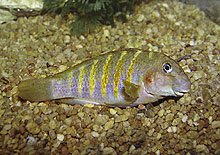
New from Karilani Island (Tanzania), Eretmodus
sp. “cyanostictus north” sport reddish vertical bars instead of the usual
yellow bars. |
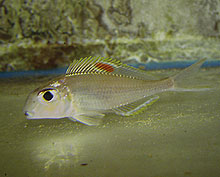
Reportedly collected at a depth of 150’ and exported
from Zambia, Xenotilapia sp. “red princess” is a new species yet
to be described. The dorsal fin is yellow anteriorly with a large bright
red blotch! |
Lake Malawi
Exports keep chugging along from all shores of Lake Malawi. Interesting
and newer items from “in between” locales are being collected and sent
from the Malawi side. Mozambique activity is stronger now as well as Tanzanian.
Bred items from commercial cichlid farms are now up to size and available
once again in good numbers.

Collected near Liuli (Tanzania), Copadichromis
borleyi “blue” usually has more of the blue hue and less of the typical
orange body coloration. |

A new species, Pseudotropheus elongatus “blue
tail” found at Mumbo Island in Malawi National Park. Photo by A. Konings. |

Not always in demand, but known from its old-time
name “golden fuscoides”, Pseudotropheus barlowi has claimed new
interest once again. |
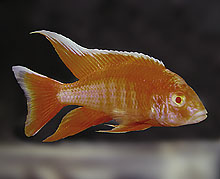
An albino form of a man-made fish, Aulonocara
“eureka red”, has been selected for its bright red markings. |

A new color morph from Jaro (Malawi), Placidochromis
sp. electra “green face” sports a yellow underside and unpaired fin markings
along with a blue body and the greenish sheen on its face, making this
variety one of the most colorful to date. |
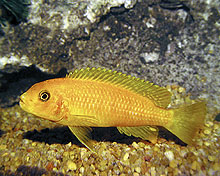
Developed in Florida, Pseudotropheus elongatus
“orange sunburst” has vibrant orange females with powder-white males sporting
orange flecks. |
Lake Victoria
A few varieties maintained only by institutions for conservation purposes
have found their way to European breeders and thus hobbyists elsewhere.
Several species are also bred on fish farms, but the numbers are dwindling
due to lack of demand. No new wild exports have been known for years.
|
what's new: Lake Victoria
|

Several varieties sporting the “typical” black body
with red finnage of Astatotilapia nubila are occasionally for sale,
although their exact species identities may not be known. |

Originally from Tanzania, Haplochro- mis sp.
“red back scraper” is currently available from bred sources. Photo by O.
Seehausen. |
West Africa
Cichlid supplies from countries in West Africa are in full swing. Congo
(riverine), Nigeria, and Cameroon top the list in cichlids exported. Often
unknown to hobbyists, many are still timid in buying these unusual items.

Recently shipped from Cameroon, Pelvicachromis
taeniatus Bandewouri is yet another color variety. |

From Cameroon, one of the many chromidotilapiines,
Benitochromis
riomuniensis Ntem. Photo by O. Lucanus. |
Neotropics
Exports from South America are still strong as of this writing. Bred
fare for ‘Cichlasoma’ species, dwarf Apistogramma species,
and discus varieties seem to be the most popular preferences among hobbyists.
Discus fans should choose from the known strains; avoid any new names and
un-established strains.
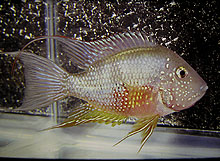
Originally from Mexico, Thorichthys maculipinnis
“Rio Obispo” (sold as T. “ellioti Rio Obispo”) is colored a
bit differently than the normal T. maculipinnis. |
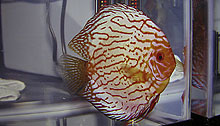
One of the many wonderful discus strains, a pigeon-blood
variety sporting the typical red eye. |
|















